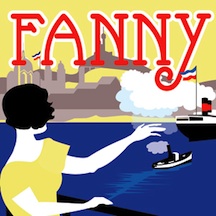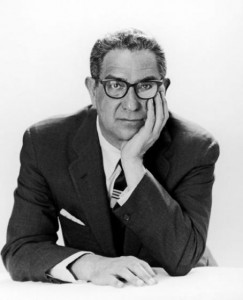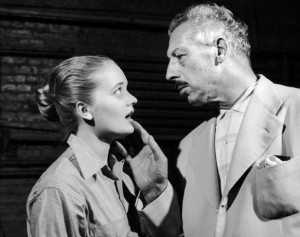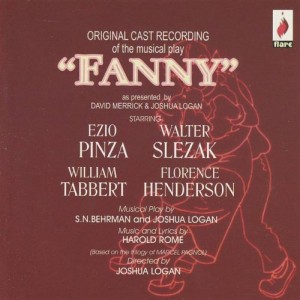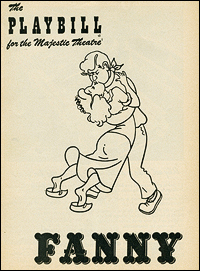GET SOME FANNY
There are many reasons to see the revival of Harold Rome’s 1954 musical Fanny at the Alex Theatre, but you only have one shot. Musical Theatre Guild (MTG), an Equity company of the finest musical theatre talent in, well, anywhere, will present this captivating Marcel Pagnol story on Monday, November 14 at 7:30. You will be amazed how the quality of MTG productions far outshines most theatre in Southern California. Even with 25 hours of rehearsal, MTG creates rarely-produced musical theatre gems – and, on occasion, a fascinating clunker – with panache and professionalism. Although scripts are in hand (an Equity rule), musical numbers are memorized, there’s an orchestra on hand (mostly), and the dancing is executed with assurance (fortunately, scripts are set aside for the movement routines). With book by S. N. Behrman and Joshua Logan, Fanny – which ran 888 performances on Broadway (longer than West Side Story!) – will be directed by Larry Raben (whose current revival of Hairspray jumps for joy in Long Beach), with musical direction by Daniel Thomas and choreography by Cheryl Baxter.
Based on the Marseillaise trilogy – the films Marius (1931), Fanny (1932) and César (1936) – and the plays that spawned these pictures, the story, quite racy for its time, concerns adolescent fishmonger Fanny (the exquisite Jennifer Shelton, reason enough to see this tuner), whose childhood love Marius (Dan Callaway) is renounced by his tavern-owning father César (Michael G. Hawkins) after the son heads off to sea for five years. But, as sailors are wont to do, Marius has left a piece of himself behind in the form of Fanny’s pregnancy. Her shameful position has mama Honorine (Marsha Kramer) encourage Fanny to marry the elderly widower Panisse (Roy Leake, Jr.), who is happy to have a scion he can call his own. The crisis occurs when Marius returns after one year to find that claiming his son and the boy’s mother are not going to be easy.
What’s Fanny going to do? And, more important, will she be able to explain why there is an incompatible belly-dancing sequence in the first act and a bizarrely placed circus in the second? No. But this confirms why every lover of musical theatre should have a season pass to MTG: not only will this truly be the one chance to see most of the musicals they put on, but the occasion invites every musical theatre aficionado to explore how and why these musicals came into being in the first place, while drooling over the original production’s behind-the-scene, juicy drama, which was sometimes more riveting than the musicals themselves.
Joshua Logan, the mastermind, co-author and director of Rodgers and Hammerstein’s South Pacific, endeavored to exceed that blockbuster show, one which had just closed the same year that Fanny would open. Logan had a severe falling out with the musical magicians of Broadway, feeling he was poorly paid for South Pacific (he even turned down The King and I in 1951). Nonetheless, Fanny was perfect material for R&H, Logan offered the project to them, but Rodgers refused to work with the most unpopular yet prolific producer in Broadway history: David Merrick.
This was the first-time musical for “Abominable Showman” Merrick, and under his watch (and pocketbook), a perfectly simple, folksy story was turned into an over-produced Broadway spectacle, which explains the ridiculous circus and the belly-dancing. Merrick would begin a long career of outlandish publicity stunts by calling the police and newspapers so that they would discover a life-sized nude statue of the show’s belly dancer in Central Park, and also plastered stickers in midtown men’s rooms which said, “Have You Seen Fanny?”
Equally hoping to top South Pacific, Merrick along with the co-creator, brought in the same lighting and set designer, Jo Mielzner; the original Emile de Becque: Ezio Pinza as Cesar; and the original Lt. Cable: William Tabbert as Marius. The topper was casting a 21 year-old girl fresh from a star turn in R&H’s Oklahoma!: Florence Henderson. (Walter Slezak as Panisse won the Tony Award for Leading Actor in a Musical.)
The bittersweet story was handed over to composer/lyricist Harold Rome, who had worked with Logan on Wish You Were Here (1952), and Fanny would be the biggest hit of his largely overlooked career. Rome was told that the music was to be “French but not too French,” and sound universally youthful without using any slang or the jazz common to the younger set in 1954.
His lush, romantic and appealing score may seem light, quaint, and airy by today’s jukebox musical standards, but some of the songs will be a revelation if you’ve never heard them before. A critic in Variety noted that Fanny may have faltered in the absence of Hammerstein’s bookwriting and plot-crafting talents, but Rome – up to then known for snappily satirical songs of social significance – wrote tunes that make it all worthwhile, headed by the pop hit “Fanny,” as well as Marius’ pulsating “Restless Heart,” Fanny’s yearning “I Have to Tell You,” Cesar’s evocative “Welcome Home,” and Panisse’s poignant “To My Wife.” Rome’s biggest claim to fame? The song “Miss Marmelstein” from I Can Get It For You Wholesale made a star out of a then-unknown talent named Barbra Streisand in 1962.
Fanny was also made into a non-musical film in 1961, also directed by Joshua Logan, starring Charles Boyer as Cesar, Leslie Caron as Fanny and Maurice Chevalier as Marius. Rome’s score from the stage production was used as background music in the film and was nominated for an Academy Award; the Best Picture Oscar that same year went to West Side Story.
OK, it has an imperfect book and an awkward second act, but there is a reason why Fanny has legions of fans, so head over to MTG and see for yourself why a perfectly good musical is hardly ever produced. While you’re there, save money on the already low ticket price and become a season subscriber. I promise you’ll get hooked, especially since you would be hard-pressed to find anything better to do on a Monday night in Los Angeles than to see a terrific show with an amazing cast in a beautiful theatre. Don’t make me beg. Their season continues with Little Women (February 13 and 19, 2012), William Finn’s masterpiece A New Brain (April 16, 2012) and concludes with Shenandoah (June 11 and 17, 2012).
Fanny
Musical Theatre Guild at the Alex Theatre in Glendale
plays one night only on November 14, 2011
for tickets, visit http://www.musicaltheatreguild.com
